Let’s explain ML concepts to a 6-year-old or a business leader 💪👨🏫
Hi All,
Simplicity is the ultimate sophistication. This is a quote often attributed to Leonardo da Vinci, and it’s a statement that rings true in many different areas including Machine Learning. There is a principle called the Feynman Razor which states if someone uses a lot of complexity and jargon (you can recall at least one of your meetings where you had to pitch in for a machine learning project) to explain something, they probably don’t understand it. The complexity and jargon are used to mark a lack of deep understanding.
As we were building and expanding our India and US teams, I interviewed around 50 candidates for Data Scientist and Sr. Data Scientist positions, I noticed a common challenge: many of the candidates struggled to explain machine learning concepts in simple terms. They were familiar with the definitions, formulas, etc, but could not explain without the jargon. This was surprising to me, as being able to clearly articulate complex ideas is an important skill for anyone working in data science. It shows the ability to understand and communicate the underlying principles of machine learning and to make them accessible to a wider audience.
In my experience, the best data scientists are able to take complex ideas and break them down into simple, easy-to-understand concepts. They can explain the basics of machine learning to someone with no technical background, create the stories from their surroundings, and can also dive deeper into the details for those who are more familiar with the subject.
👉 If you can’t explain it to a 5-year-old, you don’t really understand it! 🧒
Let’s start with everyone’s favorite p-value ✍️..
A p-value is a statistical measure that is used to evaluate the significance of a result. It is calculated based on the data that has been collected and is a way of helping us figure out if something is real or just a fluke.
In this way, a p-value is like a measure of how confident you can be in a result. If the p-value is low, then you can be more confident that the result is significant and not just due to chance. On the other hand, if the p-value is high, then you should be more skeptical of the result and consider the possibility that it occurred by chance.
Let’s say you’re trying to figure out if a certain toy makes kids happier. You give the toy to a group of kids and ask them how happy they feel on a scale of 1-10. After playing with the toy for a while, the average happiness score for a group of kids is 8.5. Now, let’s say you give the same toy to another group of kids and ask them to rate their happiness. This time, the average happiness score is only 6.5. If the p-value (some magic number 🪄) is low, it means that the difference between the two groups is probably not due to chance, and there’s likely a real difference between the two groups (boys did not like the Barbie doll 👸as much as girls adored it!)
One more story:
In the bustling city of Mumbai, Katrina found herself tangled in the web of suspicion. Her boyfriend, Salman, seemed to be drifting away, his excuses for late nights and mysterious outings stacking up like bricks in a wall of doubt. Concerned, Katrina decided to unravel the truth.
She enlisted the help of a renowned private investigator, Detective Byomkesh Bakshy, whose sharp eye and keen intuition were legendary in the city’s shadows. Detective Byomkesh trailed Salman discreetly, documenting every rendezvous, every whispered conversation, and every lingering glance.
Finally, armed with a dossier of evidence, Katrina sat down with Detective Byomkesh to decipher the clues. The report revealed a startling pattern – Salman was meeting another woman, Aish, at a cozy café with alarming frequency.
Now, faced with two unsettling possibilities, Katrina grappled with uncertainty:
Scenario 1: Salman is innocent, and his meetings with Aish are purely innocent, perhaps work-related or platonic. Scenario 2: Salman is indeed betraying Katrina’s trust, engaging in an affair with Aish behind her back.
But how could Katrina discern the truth amidst the tangled threads of suspicion? Enter the enigmatic concept of the p-value.
The p-value, whispered Detective Byomkesh, was the key to unlocking the mystery. It served as a compass, guiding Katrina through the murky waters of uncertainty.
A low p-value, like a shimmering beacon in the darkness, would signal that the evidence – Salman’s frequent meetings with Aish – was highly improbable if he were innocent. It would suggest that scenario 2, the betrayal, loomed ominously on the horizon.
Conversely, a high p-value would cast doubt on the significance of the evidence, hinting that scenario 1, innocence, was still a plausible explanation.
In Katrina’s case, a minuscule p-value would tip the scales decisively, suggesting that Salman’s innocence was a mere illusion, shattered by the weight of damning evidence.
Yet, Detective Byomkesh cautioned, the p-value alone was not a verdict but a compass needle, pointing toward truth or deception. Katrina would need to weigh other factors and consider additional evidence, before reaching a final judgment.
In Katrina’s journey through the labyrinth of suspicion, the p-value illuminated a path, revealing the stark reality hidden beneath the veneer of deceit.
Gradient Descent ⛰️
ChatGPT Prompt: “In the scene, there is a large hill and a man is running down it. The man is moving quickly and is using his legs to propel himself forward as he descends the hill. He may be running for exercise, for fun, or for some other reason. The hill is steep and the man is using all of his strength and coordination to keep his balance as he runs down it. The scene is outdoors and the man is surrounded by nature, with trees and other vegetation visible in the background.”
DALLE.E output is below:

Gradient descent is an algorithm that helps us find the best solution to a problem. Imagine you are standing on a hilly landscape and you want to get to the bottom of the biggest hill as quickly as possible. You can walk around, take a few steps, stop and look around to see how close you are to the bottom, and then look for the place where the ground is lowest beneath your feet. The best way to do this is to take small steps in the direction that will take you down the hill the fastest. If you are close to the bottom, you can keep going in the same direction. But if you are far away, you might want to try a different direction. This is like how gradient descent works - it uses math to figure out the best way to move toward the minimum point in a set of hills or valleys by taking small steps in different directions.
Recall and Precision
Imagine that you are a happily married man of 10 years. One day, out of nowhere, she asks you:
‘Sweetie, do you remember all our anniversary celebrations?’
This seemingly simple question can turn your life into chaos. You must remember all 10 anniversaries accurately. Recall is the ratio of the number of anniversary celebrations you can accurately remember to the total number of your anniversaries. So, if you can recall 8 out of 10-anniversary venues, your recall ratio is 0.8. Beware! You missed 2.
If you claim to have celebrated 11 anniversaries together and can remember 10 with great effort, your precision is 0.91. Therefore, precision is the ratio of the number of events you can correctly recall to the total number of events you recall (a mix of correct (10) and incorrect recalls (1)). In other words, it measures how precise your recall is. In this scenario, too, you are in danger, as you claimed to have celebrated 11 anniversaries!!
LLM Agent
In the city of Datapolis stands the unique General Hospital. This hospital operates quite differently from others, mirroring the functionality of a Large Language Model (LLM) agent.
At the entrance, you’re greeted by the ever-friendly receptionist, Sarah DJ. Sarah is responsible for taking in all the “patients” (queries) that come through the door. She doesn’t treat anyone herself, but she’s crucial in understanding what each patient needs and directing them to the right department. Once Sarah processes a query, she sends it to the Routing Department, headed by Dr. Tom Parser. Dr. Parser and his team break down the query into smaller, manageable pieces - much like how an LLM tokenizes input text. These tokenized queries are then sent to the hospital’s central hub: the Massive Knowledge Center. This vast library contains information on virtually every topic imaginable, accumulated over years of “training”.
Depending on the nature of the query, different specialists are called upon:
Dr. Emily Context specializes in understanding the broader implications of each query. Dr. Raj Semantics, an expert in deciphering the true meaning behind words. Dr. Lisa Logic, who ensures that responses make rational sense. Dr. Miguel Creativity, for cases requiring imaginative solutions.
Drawing upon the Massive Knowledge Center, these doctors collaborate to formulate a response. Their collective effort mirrors how an LLM processes information across its neural network. Finally, the response is sent to Dr. Alex Output, who structures it into coherent language, much like the output layer of an LLM. The final “treatment plan” (response) is then delivered back to the patient via Sarah. This process happens quickly, often in seconds, like how LLMs can rapidly generate responses. The hospital is always learning, adding new information to the Massive Knowledge Center, mirroring how LLMs can be fine-tuned or updated with new data.
Thank you! Happy New Year!!





Leave a comment